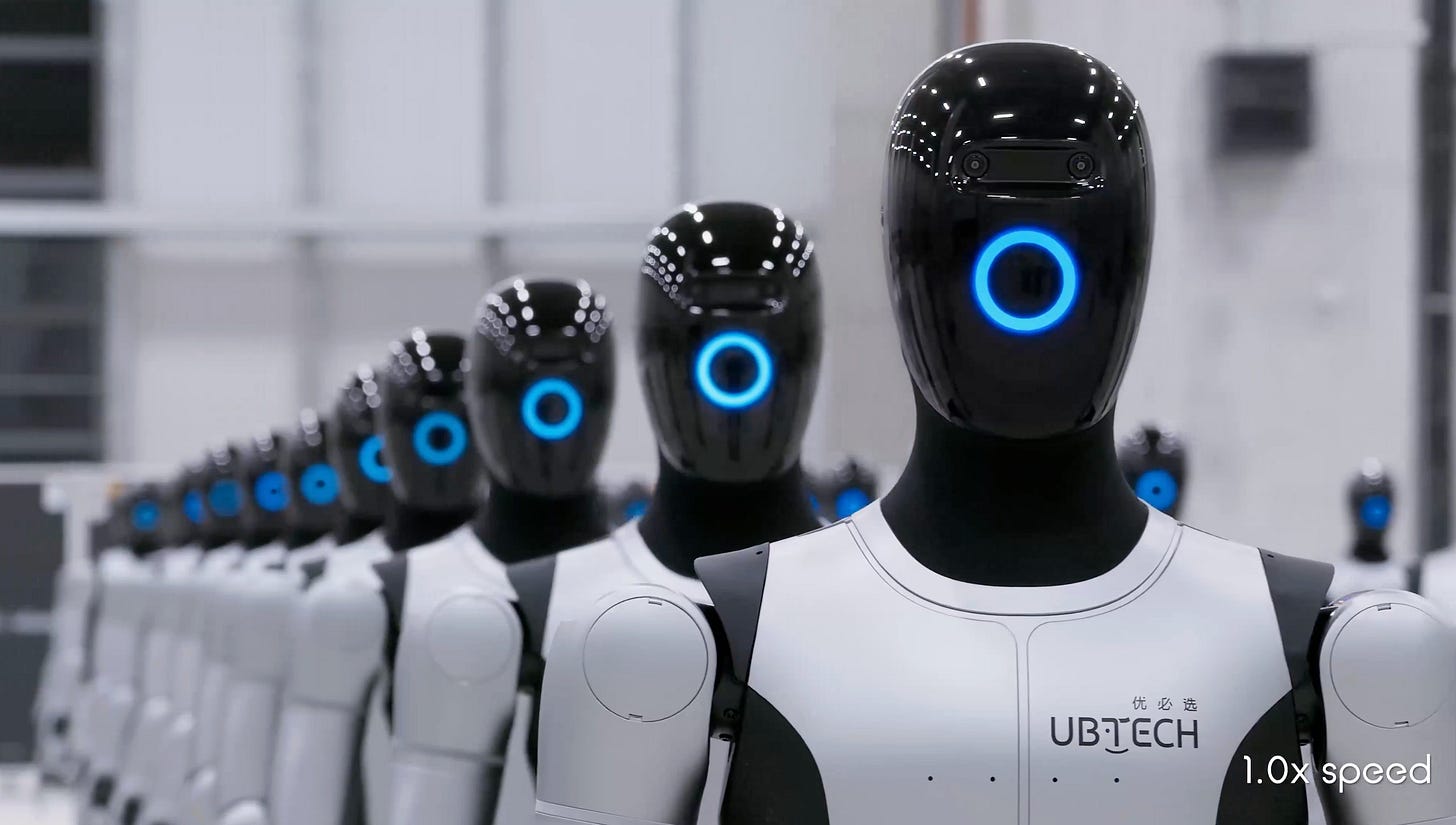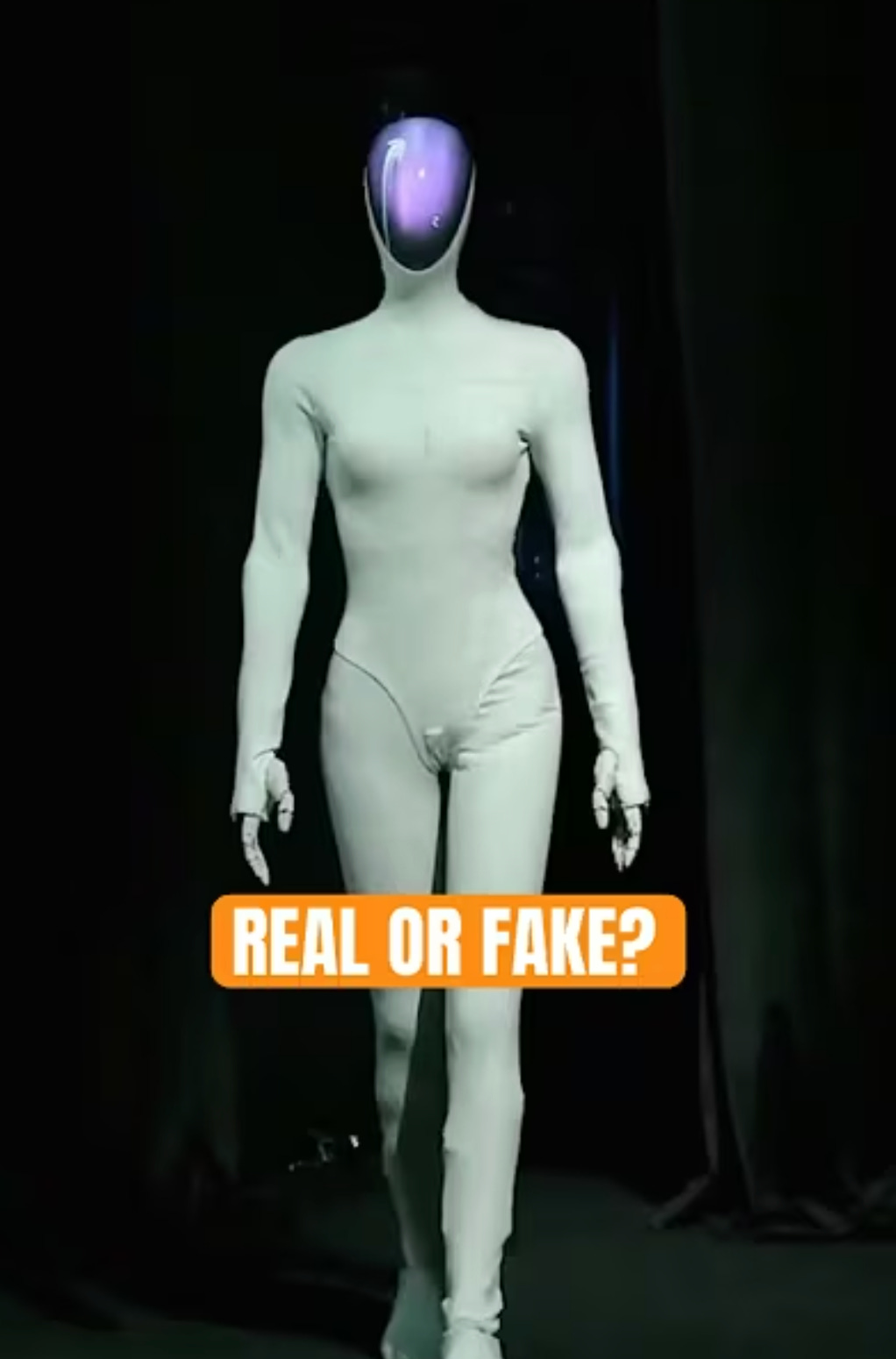Don’t Be Fooled by the Robots. China’s Latest Spectacle Has One Purpose: Fear.
The Terminator isn’t the real threat, but Beijing would love for you to think it is.
Last week, two Chinese robot videos went massively viral. One showed a humanoid “model” walking down a runway with an uncannily human gait. The debate around “Is it a robot or a human in a suit?” spread exactly the way the robot maker’s CEO seemed to hope it would.
If you missed it, here’s what it looked like:
The second viral clip showed rows of humanoid robots marching in formation like a mechanized army on their way to be shipped out in Chinese robot maker, Ubtech’s first large-scale delivery. It was a moment staged to look far more military than industrial. And people reacted exactly the way Beijing wanted.
None of this was really about robotics. It was about psychology.
Optics Are the Point
Humanoid robots are nowhere close to replacing humans at scale. Outside of scripted demos, most
can’t operate reliably in real-world environments. They struggle with balance, coordination, and even basic manipulation. China knows this. But the goal of these videos is impact, not accuracy.
Spectacular images spread faster than facts and perception—especially fear—is a powerful currency.
China’s economy is in one of its most fragile periods in decades with rising debt, shrinking investment, and youth unemployment so high the Chinese regime simply stopped reporting it. Political leadership is fractured and social unrest continues to grow.
So, spectacle becomes a useful distraction.
As written in the ancient Chinese book on war and strategy, “The Art of War” by Sun Tzu: “Appear strong when you are weak.”
A quick reminder here: China’s robot makers don’t operate independently the way American robot makers, like Boston Dynamics or Tesla, do. In China, any company of strategic value is essentially intertwined with the CCP. So comparing U.S.-made robots vs Chinese-made robots is misleading.
Remember, they’re building for very different masters, with very different goals.
Why We’re Wired to Fear Robots
There are few images that travel faster than humanoid robots.
Most of us grew up with The Terminator as our mental reference point, not friendly service bots or clumsy factory arms. So when we see a humanoid walking smoothly or marching in formation, our nervous system reacts before we even think about it.
It feels threatening, familiar, and alien at the same time.
And here’s an interesting fact that most people don’t know:
China’s national surveillance system—the real one that is in place surveilling its citizens—is actually called Skynet. The same name as the destructive, rogue AI in The Terminator.
Yes. Not subtle at all.
So when Beijing pushes out dramatic robot footage, it’s playing straight into a fear we’ve carried for decades, alongside new narratives of job replacement. And China wants to be the writer of the new narrative, whether it’s based on fact or not.
The Two Layers of Skin
While researching my book Who Are China’s Walking Dead?, former CCP officials taught me a phrase that describes the CCP approach to propaganda to represent it’s regime. In China’s CCP Propaganda Department, they call it “Two Layers of Skin.”
This help explains exactly what’s happening:
Every message has two layers of skin.
The outer layer: what the public is meant to see.
The inner layer: the real intention—often hidden even from the officials delivering it.
In China’s robot optics:
Outer layer: a futuristic “robot army.”
Inner layer: a system under pressure, using spectacle to mask vulnerability.
You can use this to understand geopolitics, but you can also use it to understand everyday news around you.
Fear Is a Tool.
Once you understand the two-layer logic behind these spectacles, the goal of creating fear is more recognizable. Because China’s robot displays aren’t designed to show capability. They’re designed to show power. Or rather, the appearance of it.
Fear pushes people into urgency, distraction, and worst-case thinking. It keeps the focus on the spectacle instead of the substance. And in a world saturated with information overload and manufactured tension, it doesn’t take much to tip the nervous system into overdrive.
That’s why fear gets used by governments, corporations, and anyone who benefits when the public can’t tell the difference between what’s loud and what’s true.
Clarity interrupts that.
But clarity doesn’t arrive when the mind is in alarm mode. It arrives when the mind is steady and calm. Because fear narrows your view, while calm widens it.
Because at the end of the day, robots don’t decide our future, systems don’t define our worth, and fear doesn’t get the final say unless we hand it over.
What About You?
👉 When those robot or AI clips pop up, what’s your gut reaction?
👉 And how do you know when something’s hype instead of truth?
Your perspective helps others think more clearly too.
Click to add your comment and join the discussion.
For Members Only
This week, I’ve unlocked Chapter 3: “Two Layers of Skin” from my book Who Are China’s Walking Dead? It’s the chapter where former CCP judges and propaganda officials explain exactly how Beijing constructs these illusions.
If you want the deeper lens behind today’s post, it’s waiting for you.
The Two Layers of Skin: Why China Says One Thing and Does Another
This week’s MEMBER VAULT post is something special—an excerpt from my book Who Are China’s Walking Dead? A personal journey into the strange world of communist culture and officialdom.
Till next week, Stay Calm, Stay Strong, Stay Human.
~ Kay
PS: A special thanks to a CALM REBELLION reader, Roger Arendse, who shared a thoughtful article on awe that pairs beautifully with today’s topic. Click here to read if you want another angle on clarity. Thanks, Roger!
Kay Rubacek is a communications strategist and certified stress consultant who helps leaders stay calm, clear, and effective in a world built to overwhelm them. With 25+ years in media and human-rights storytelling, she now teaches mission-driven people how to use calm, clarity, and human value to lead and communicate with strength.






So true, thank you Kay for clarifying that, I totally agree!
The things you write about and the way you write...so great. In my opinion.